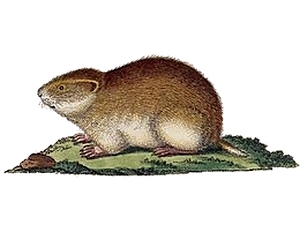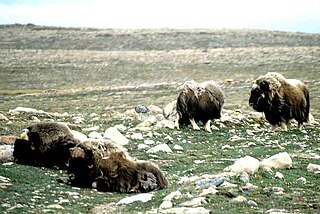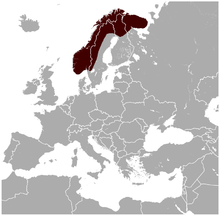
The reindeer or caribou is a species of deer with circumpolar distribution, native to Arctic, subarctic, tundra, boreal, and mountainous regions of Northern Europe, Siberia, and North America. It is the only representative of the genus Rangifer. More recent studies suggest the splitting of reindeer and caribou into six distinct species over their range.

The pink-footed goose is a goose which breeds in eastern Greenland, Iceland, Svalbard, and recently Novaya Zemlya. It is migratory, wintering in northwest Europe, especially Ireland, Great Britain, the Netherlands, and western Denmark. The name is often abbreviated in colloquial usage to "pinkfoot". Anser is the Latin for "goose", and brachyrhynchus comes from the ancient Greek brachus "short" and rhunchos "bill".

The Arvicolinae are a subfamily of rodents that includes the voles, lemmings, and muskrats. They are most closely related to the other subfamilies in the Cricetidae. Some authorities place the subfamily Arvicolinae in the family Muridae along with all other members of the superfamily Muroidea. Some refer to the subfamily as the Microtinae or rank the taxon as a full family, the Arvicolidae.

The tundra vole or root vole is a medium-sized vole found in Northern and Central Europe, Asia, and northwestern North America, including Alaska and northwestern Canada. In the western part of the Netherlands, the tundra vole is a relict from the ice age and has developed into the subspecies Alexandromys oeconomus arenicola.

Lemmini is a tribe of lemmings in the subfamily Arvicolinae. Species in this tribe are:

The northern collared lemming or Nearctic collared lemming, sometimes called the Peary Land collared lemming in Canada, is a small lemming found in Arctic North America and Wrangel Island. At one time, it was considered to be a subspecies of the Arctic lemming. Some sources believe several other species of collared lemmings found in North America are actually subspecies of D. groenlandicus.

The Amur lemming is a species of lemmings found near the Amur River in Siberia.

The Canadian lemming or Nearctic brown lemming is a small North American lemming.

The barren-ground caribou is a subspecies of the reindeer that is found in the Canadian territories of Nunavut and the Northwest Territories, in northern Alaska and in south-western, Greenland. It includes the Porcupine caribou of Yukon and Alaska. The barren-ground caribou is a medium-sized caribou, smaller and lighter-colored than the boreal woodland caribou, with the females weighing around 90 kg (200 lb) and the males around 150 kg (330 lb). However, on some of the smaller islands, the average weight may be less. The large migratory herds of barren-ground caribou take their names from the traditional calving grounds, such as the Ahiak herd, the Baffin Island herds, the Bathurst herd, the Beverly herd, the Bluenose East herd, the Bluenose West herd, the Porcupine herd and the Qamanirjuaq herd.

The grey red-backed vole or the grey-sided vole is a species of vole. An adult grey red-backed vole weighs 20-50 grams. This species ranges across northern Eurasia, including northern China, the northern Korean Peninsula, and the islands of Sakhalin and Hokkaidō. It is larger and longer-legged than the northern red-backed vole, which covers a similar range and it is also sympatric with the Norwegian lemming.

The Arctic lemming is a species of rodent in the family Cricetidae.

The WestSiberian lemming or Western Siberian brown lemming is a true lemming species found in the Russian Federation. Like other lemmings, it belongs to the Cricetidae family of rodents.

A lemming is a small rodent, usually found in or near the Arctic in tundra biomes. Lemmings form the subfamily Arvicolinae together with voles and muskrats, which form part of the superfamily Muroidea, which also includes rats, mice, hamsters, and gerbils. In popular culture, a longstanding myth holds that they exhibit herd mentality and jump off cliffs, committing mass suicide.

The Weichselian glaciation was the last glacial period and its associated glaciation in northern parts of Europe. In the Alpine region it corresponds to the Würm glaciation. It was characterized by a large ice sheet that spread out from the Scandinavian Mountains and extended as far as the east coast of Schleswig-Holstein, northern Poland and Northwest Russia. This glaciation is also known as the Weichselian ice age, Vistulian glaciation, Weichsel or, less commonly, the Weichsel glaciation, Weichselian cold period (Weichsel-Kaltzeit), Weichselian glacial (Weichsel-Glazial), Weichselian Stage or, rarely, the Weichselian complex (Weichsel-Komplex).

Reindeer in Russia include tundra and forest reindeer and are subspecies of Rangifer tarandus. Tundra reindeer include the Novaya Zemlya (R.t.pearsoni) and Sápmi subspecies and the Siberian tundra reindeer.

According to the northern cryptic glacial refugial hypothesis, during the last ice age cold tolerant plant and animal species persisted in ice-free microrefugia north of the Alps in Europe. The alternative hypothesis of no persistence and postglacial immigration of plants and animals from southern refugia in Europe is sometimes also called the tabula rasa hypothesis.

The Canadian Low Arctic Tundra ecoregion covers a rolling landscape of shrubby tundra vegetation along the northern edge of the mainland Canada along the border of the Northwest Territories and Nunavut, and a small portion in Quebec on the northeast coast of Hudson Bay. The region is important for large herds of caribou and other large mammals, and for large nesting colonies of birds such as snow geese. The region is mostly intact, with 95% remaining intact.

The Canadian Middle Arctic Tundra ecoregion covers a broad stretch of northern Canada - the southern islands of the Arctic Archipelago, plus the northern mainland of Nunavut and, across Hudson Bay to the east, a portion of northern Quebec. This is the coldest and driest ecoregion in Canada, and can be referred to as a 'polar desert'. It is an important region for breeding and migratory birds, and supports 80% of the world's muskox.

The East Siberian lemming, Eastern Siberian brown lemming, or Ognev's lemming is a species of lemming endemic to Russia, where it has a disjunct distribution throughout parts of Siberia east of the Verkhoyansk Range.

The Beringian lemming or Beringian brown lemming is a species of lemming found in Russia and North America.



























